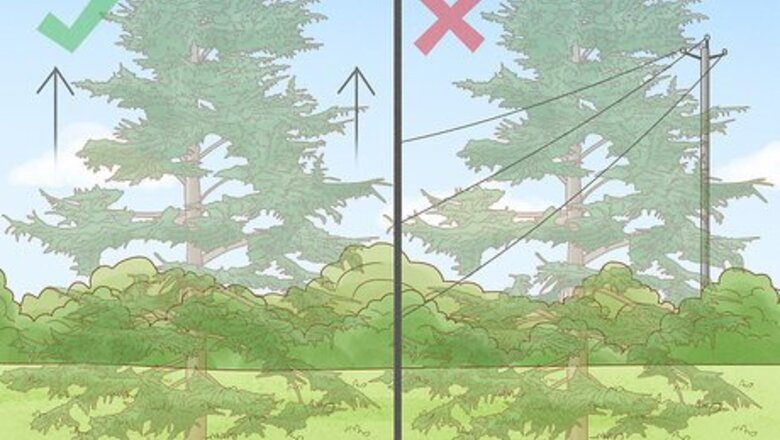
views
X
Research source
Material gathered from these plants can be used in carpentry, shingles, incense and art. Once you’ve found a cedar tree that grows well in your climate and region, take care to plant it and care for it while it is young and vulnerable.
Choosing a Spot to Plant
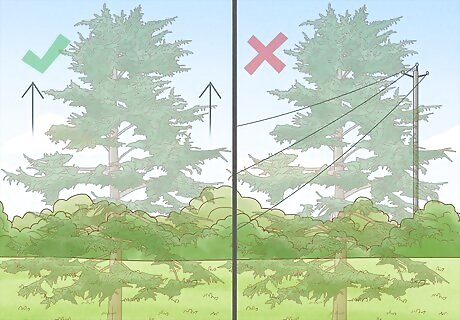
Choose a location that doesn’t block vertical growth. Whenever you are planting, envision the height of your cedar tree when mature. Cedar trees can grow very large. Depending on the specific type of cedar, they generally grow up to 50ft. (15m), but can be over 100ft. (30m) tall. Look for a clear area that has nothing hanging above where the tree might grow. Find a location that is not directly below electric or cable lines, roofs or existing trees. Ensure you aren’t planting directly above a septic system or well. The roots will reach deeply into the ground.
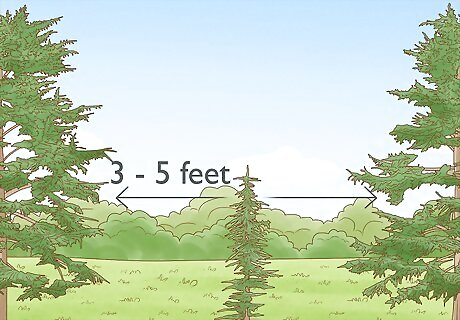
Provide enough space for horizontal growth. Plant small trees at least three feet apart, but preferably up to five feet apart. The trees need space between each other so they aren’t fighting for the same water and root territory. Calculate the space you have, especially if you’re planning a hedge or border, and ensure you have enough room to have enough spacing for the number of trees. If you are growing a cedar hedge, the outermost branches of the bottom foliage should be roughly an inch apart when the trees are planted.
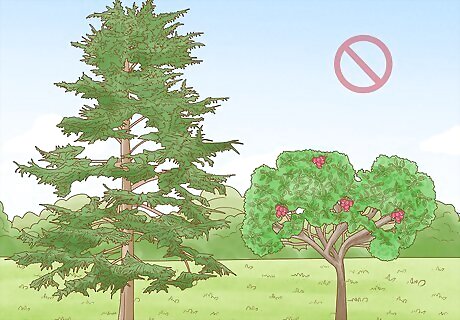
Avoid locations near fruit trees. When planted near fruit trees (e.g. apples, crabapples, pears, quince), a rust disease can infect the nearby trees. There are multiple varieties of the disease, usually the name of the tree followed by the suffix “rust.” For apple trees, it would be cedar-apple rust. Look for yellow or reddish lesions, gelatinous shapes, or other fungus. The rust disease doesn’t kill the trees or the fruit, but it does cause an eyesore. Prevention of the disease can be accomplished via adequate pruning and fungicide application.
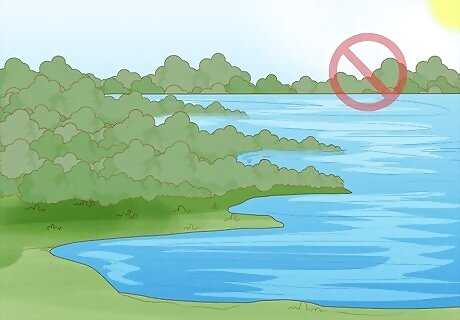
Choose a spot away from large amounts of water. The roots will need plenty of space to dig into the surrounding area. If the tree roots are too close to the water, or are in water too long, they may not have the support they need to grow new roots. When it comes to excessive water exposure and flooding, cedar trees are one of the more intolerant species of trees. Death of the tree can occur in less than a month if the water exposure is significant. Younger trees are more susceptible. Healthy trees stand a better chance of avoiding water damage. Stressed trees are more likely to suffer damage.
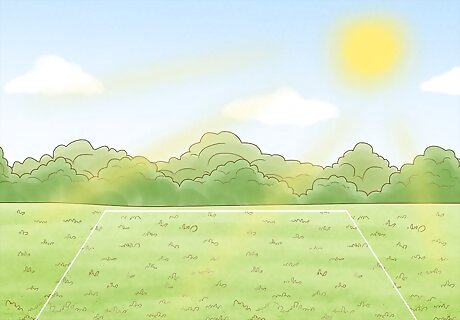
Select an area with significant sun exposure. Although they can grow in partial sun, they will grow faster in the sunlight. There should be at minimum 6 hours of direct sunlight every day. Cedar trees can actually benefit from full sun exposure, so choose a location that doesn’t have significant eastern or western sunlight blockage.
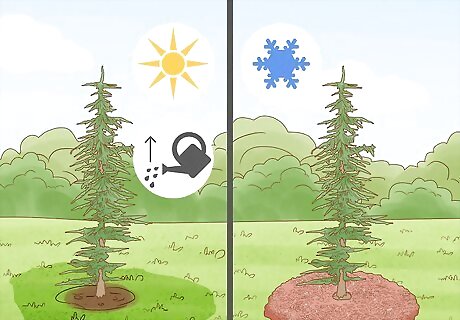
Adapt your plan to suit your climate. While most cedar trees can thrive in a variety of climates with minimal interaction, a lack of moisture could impact their health. Some trees that have not received appropriate moisture become more susceptible to insect infestation and disease. Very hot locations should receive extra watering whenever possible to prevent the trees from going into shock and dying. Very cold locations should receive extra layers of mulch in order to protect against frozen root systems.
Planting Cedar Trees
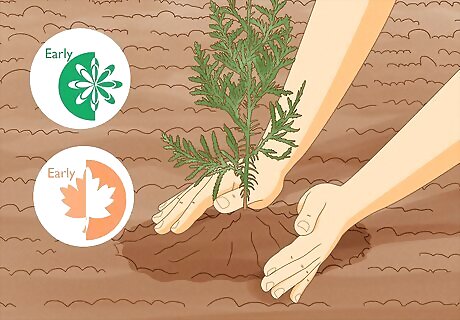
Time the planting appropriately. Wait until after the final thaw, and plant the trees in the early spring. They could also be planted in the early fall. The primary danger to planting at the wrong time is exposure to heat and heatwaves. The young hedges need ample water, and excessive heat could prove fatal. Early fall planting may be a better option if your area limits water because of the temperature or heat.
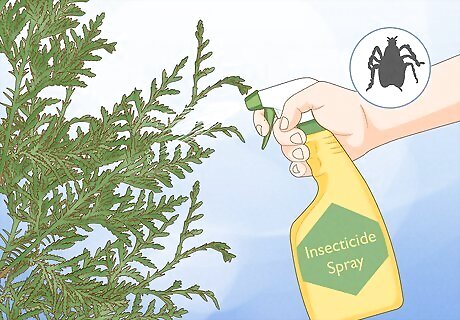
Remove the tree from its packing. Seedlings are often in buckets, containers, or burlap to facilitate transfer. Depending on how the tree is packaged, you will have to remove it before planting. Follow the guideline below depending on your cedar tree. Bare root trees still have packaging material. Remove it before doing anything else. Burlap packaging can be removed after placing the tree in the hole. Remember to get all twine and nails that keep the packaging together. Some burlap under the tree may remain, particularly if the tree bulb is heavy. If the burlap is treated or vinyl, however, it needs to be completely removed. To remove the tree from a container, pick it up at a 45 degree angle, supporting the tree against your leg or body. Slowly rotate the bucket and firmly pat the outside of the bucket. The pat should have a slight downward angle, and be forceful enough to dislodge the tree.
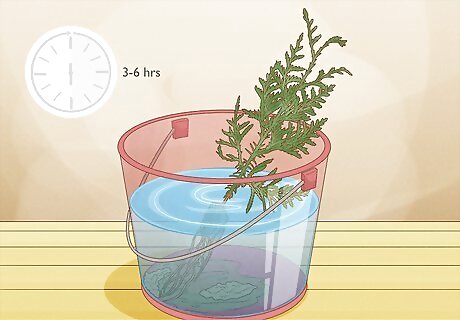
Keep bare root seedlings moist. If the roots are bare, and not already in a dirt or soil bulb, you’ll need to place it in water. Place the roots in a bucket of water during the time before you plant. Take care not to disturb the roots until you must. The advised amount of time in the water is approximately 3-6 hours. You can keep the roots submerged in the water bucket for up to a week before they start to rot.
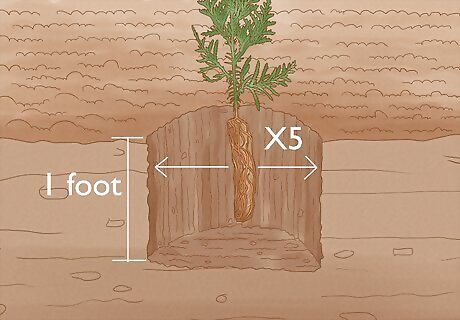
Dig a hole. In general, the hole should be big enough to accommodate the size of the root ball. Some recommend a sloped-side hole about a foot deep and five times as wide as the root ball. The root collar should be above the level of the land. Using a roto-tiller could greatly expedite the process as well as aerating the soil.
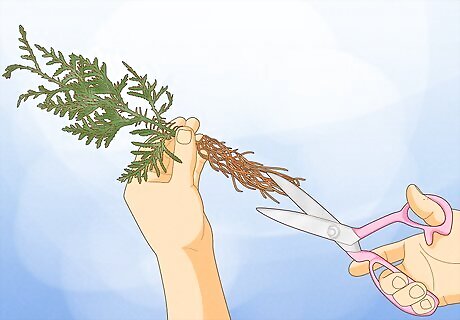
Cut any compacted roots. Trimming off an inch of the root edges, or cutting lines into interwoven tree roots that have circled a container, is a good way to encourage root growth. Cutting a few vertical lines up the length of the root ball, and one criss-cross on the bottom, should help loosen the roots. You may not need to cut any roots at all. If the roots do not look interwoven, then cutting the smaller root fibers is not necessary.
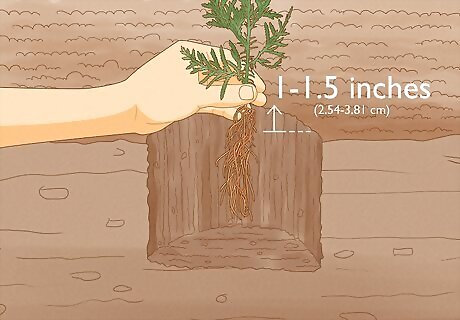
Place the tree in the hole. Aim for the center of the hole. Once inside the hole, the root ball should be above 1-1.5 inches (2.54-3.81 cm) above the ground on all sides, so there is a slight crown to allow for drainage and proper mulching. Be sure to support the root ball instead of the moving it around by the tree or its limbs. If the tree collar is lower than ground level when you place it in the hole, add some soil under the root bulb and re-situate the tree.
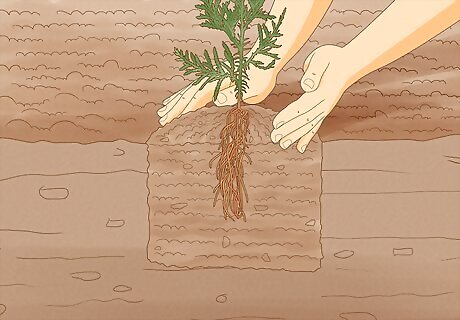
Align the roots and fill the hole. Point the roots downward as best possible, and fill the remaining hole with the pile of dug up soil. Compact the soil very tightly around the roots, and remove any air pockets. Use good planting soil and fresh compost to guarantee the roots have plenty of nutrients. Avoid adding any soil amendments like peat. They could potentially hinder root expansion. Fertilizer and other chemicals are not necessary when initially planting.
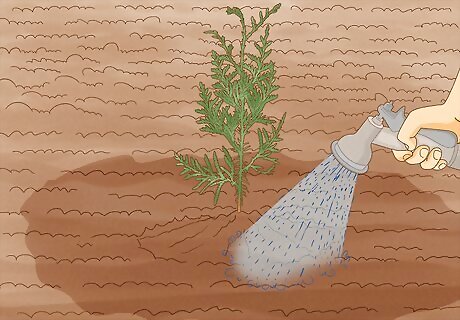
Water the tree. Push the soil around the drip line of the tree to form a water-holding ring around it. Water it thoroughly in the trench, then refill the trench with soil. The tree should get about an hour worth of water per week. Water it once per day in hot conditions, and less when it rains frequently. The dripline is the ring beneath the outer branches of the tree. To water the dripline, walk around in a circle. Water each spot in the circle for a few seconds before moving onto the next spot. If the tree changes colors, it may be receiving too much water. If the tree gets dried out and prickly, the water is likely insufficient.
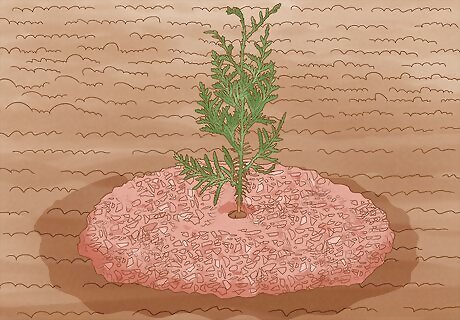
Spread mulch around the tree. Mulch is beneficial to the cedar because it provides some moisture when hot, and insulation when cold. The protective mulch should be a few inches deep, covering all the soil that has been dug up. It works best if the mulch is also a couple inches removed from the trunk.
Caring For Cedar Trees
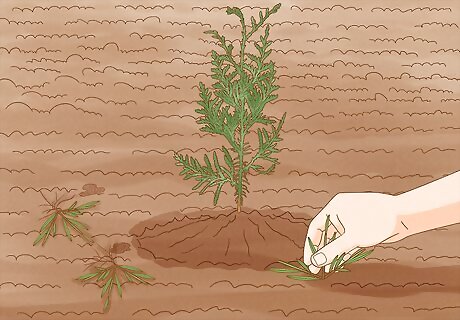
Weed the area. Around the seedling, regularly pull weeds by hand. Avoid using a weed-eater near the tree, to ensure there is no damage to either the trunk or the limbs. If weeds are left unchecked, they can potentially sap away much needed moisture and nutrients from the sapling. Further, taller weeds could block sunlight. Overgrown weeds are the primary cause of death for young seedlings. Do not dig up roots deeper than 3 inches (7.62cm). Landscape fabric with accompanying mulch can also be used to combat weed issues.
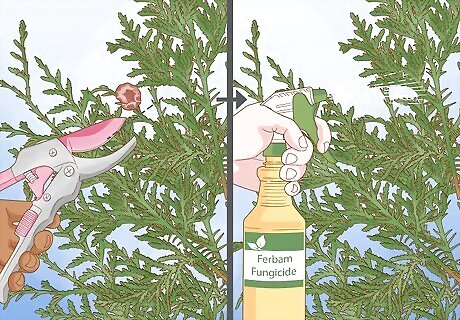
Prevent potential disease. The cedar tree can often get galls, which are brain or mop shaped fungi. This can lead to cedar-apple rust with surrounding trees in the apple family. If there is no location for the fungi to go, then it will terminate on the cedar tree. The best way to manage this infection is to trim the galls, then spray with a fungicide like Ferbam in late summer. If the tree is being attacked by a lot of bugs, it could be exposed to too much water, and dying from underneath. Use an insecticide like malathion to treat the tree.
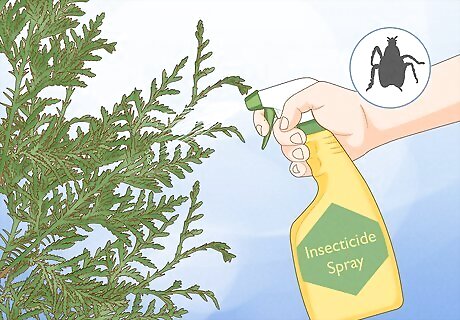
Malathion, is deemed a carcinogen by IARC, International Agency for Research on Cancer. Cedars have grown in the wild for millions of years without the use of insecticides, those less hardy then die out, improving the gene pool. By using known carcinogens we are polluting waterways, fisheries, microbial life in living soil, and ourselves. The absence of insecticides allow for weaker cedars to die off, thus improving the gene pool.
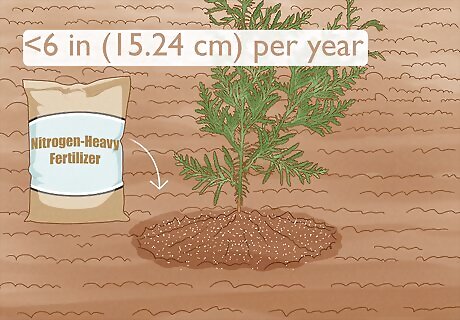
Fertilize the soil around the tree as needed. Fertilizers will be necessary when there is poor growth – less than 6 inches (15.24 cm) per year – or if there is severe discoloration. If the poor growth is the only problem, then nitrogen-heavy fertilizer should work. Other problems are more closely related to nutrient deficiencies, and require a soil sample to examine the pH level. Trees have greatest growth in spring, so fertilize just before then. If the soil is sandy, some fertilizer can be applied earlier in spring, with a later application in late May. Fertilizer during hot conditions should be immediately followed by a thorough watering.
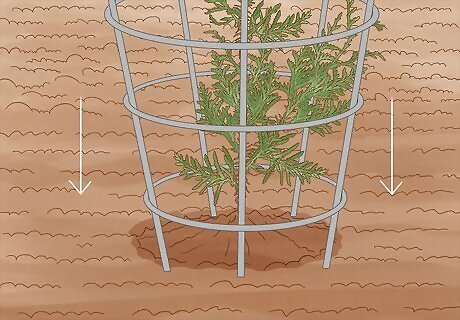
Cage young cedar. Until the trees are mature, they are susceptible to wintering deer and rabbits. A wire mesh cage works well to disinterest foragers. To effectively counteract deer, the fencing should encompass the tree just around the canopy, and low enough so the animals can’t squeeze under. It should also be anchored to the ground so the animals can’t knock it aside.

















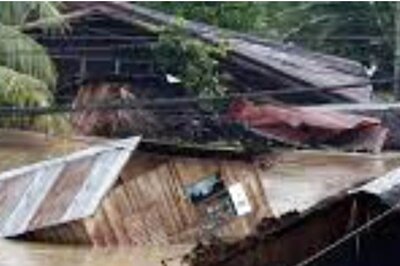


Comments
0 comment